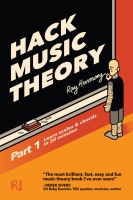There are an infinite number of musical compositions, and that's a problem for anyone trying to write one. Specifically, most of them sound really bad. The infinity of choices doesn't just make it hard to evaluate the best path from concept to finished result, it also makes it hard to refine the initial concept into a solid starting position. As Ansel Adams said, there is nothing worse than a sharp image of a fuzzy concept
.

Hack Music Theory Part 1
Ray Harmony
ISBN: 9781988410036
Revolution Harmony, 2016-06-23
English
A must-read. The best ten dollars you can spend as a beginning musician. (5/5)
Music theory can, at worst, be a way to suck all the joy and beauty out of the art and turn it into some kind of theory for its own sake, a numerologic nerdy mess utterly divorced from actual sound. However, when used properly, music theory gives you a language and a grammar that lets you dispense with the myriad of tiny decisions involved in composing music and work at a higher, more expressive, level. If you then want to tweak the composition and break a few rules then you are of course free to do so, but you will be breaking them intentionally and knowingly.
Hack Music Theory aims to be a book about music theory for people who use it as a tool to create music. It is a very short book - 83 pages, which you'll go through in about an hour or so on your first read - and goes into just enough depth that the theory is useful. This is a working musician's music theory, not a music theorist's. In short, this book is a must-read and the best ten dollars you can spend as a beginning musician.
The book covers pretty much what it says on the cover - scales and chords. You'll learn what a scale is, why it matters and how it fits into music creation, and how scales are used to create chords, and how they fit in. It's all very easy reading, and Ray limits the book to major and minor scales (what's also called Ionian) and Aeolian scales), and major and minor chords.
My only nitpick is that it doesn't cover chord inversions[a] or suspended chords[b], which is a concept you'll need for the follow-up Hack Music Theory: Songwriting and Producing. Fortunately inversions and suspended chords are easy to figure out, so this is not a major flaw.
It helps to have a keyboard or some instrument nearby while reading, so you can try things as you go and get a feel for the theory, but this is not required. Personally I'd recommend having LMMS[c] open with a piano and a piano roll.